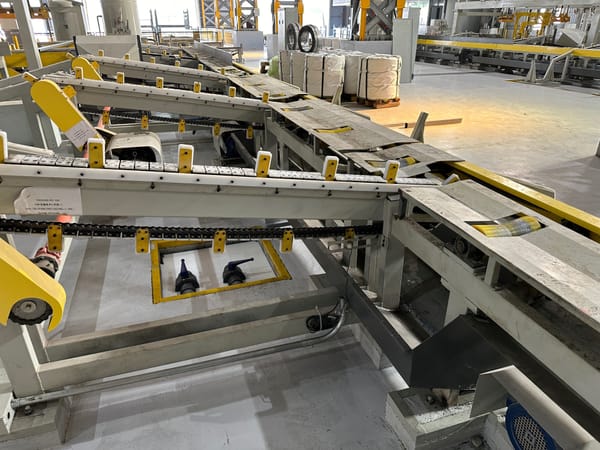
The final stage in the ERW tube mill process involves handling the finished pipes or tubes by stacking and strapping them for storage, transportation, and delivery. This is typically performed by automated or semi-automated machinery to ensure efficiency, safety, and proper packaging of the products.
Stacking Machine
After the cut-to-length pipes or tubes exit the cut-off equipment, they are conveyed to the stacking machine. The primary function of the stacking machine is to collect and arrange the individual pipes into organized bundles or stacks. These machines are designed to handle various pipe lengths, diameters, and shapes (round, square, rectangular).
Key features and processes
Counting and Alignment The machine accurately counts the pipes and aligns them precisely to form a uniform layer within the bundle.
Layer Formation Pipes are typically stacked in layers, often in hexagonal or square configurations, depending on the pipe shape and customer requirements.
Automated Transfer Once a layer is complete, it is automatically transferred to form the next layer, building up the bundle to a predetermined height or pipe count.
Gentle Handling Modern stacking machines are designed to handle pipes gently to prevent surface damage or deformation.
Strapping Machine
Once a bundle of pipes has been formed by the stacking machine, it proceeds to the strapping machine. The strapping machine secures the bundle with straps (typically made of steel or high-strength plastic) to keep the pipes tightly together, preventing movement and damage during handling and transit.
Key features and processes
Automatic Strapping The machine automatically applies and tensions multiple straps around the pipe bundle. The number and placement of straps depend on the bundle size and weight.
Tensioning and Sealing Straps are tensioned to a specific force to ensure the bundle remains secure. They are then sealed, often through friction welding or crimping, to create a strong, permanent bond.
Bundle Formation The strapping process completes the formation of a secure, ready-to-ship bundle.
High Automation Many systems offer high levels of automation, integrating seamlessly with the stacking process to minimize manual labor and increase throughput.
Importance of Automation
Automated stacking and strapping systems offer significant advantages
Increased Efficiency Reduces manual labor and speeds up the packaging process.
Improved Safety Minimizes human interaction with heavy pipe bundles, reducing the risk of injuries.
Consistent Quality Ensures uniform bundle formation and secure strapping, leading to better product presentation and reduced damage during logistics.
Space Optimization Organized stacking allows for more efficient use of storage space.
In conclusion, the Steel Pipe Stacking and Strapping Machine is the final step in the ERW tube mill, ensuring that the high-quality pipes and tubes produced are properly prepared for their journey to the customer, maintaining their integrity and value.
